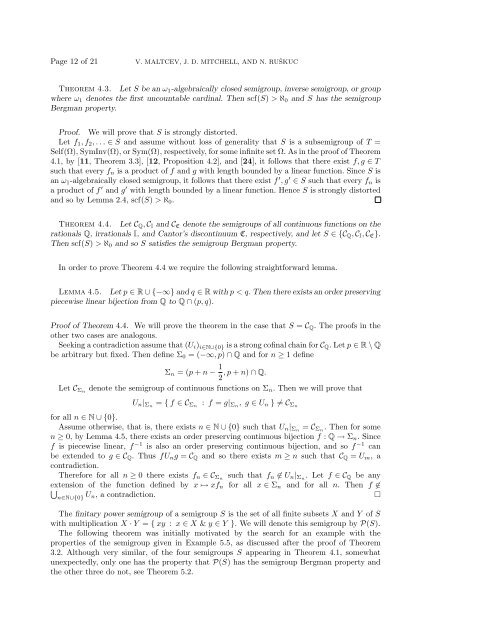The Bergman property for semigroups
The Bergman property for semigroups
The Bergman property for semigroups
You also want an ePaper? Increase the reach of your titles
YUMPU automatically turns print PDFs into web optimized ePapers that Google loves.
Page 12 of 21<br />
V. MALTCEV, J. D. MITCHELL, AND N. RUŠKUC<br />
<strong>The</strong>orem 4.3. Let S be an ω 1 -algebraically closed semigroup, inverse semigroup, or group<br />
where ω 1 denotes the first uncountable cardinal. <strong>The</strong>n scf(S) > ℵ 0 and S has the semigroup<br />
<strong>Bergman</strong> <strong>property</strong>.<br />
Proof. We will prove that S is strongly distorted.<br />
Let f 1 , f 2 , . . . ∈ S and assume without loss of generality that S is a subsemigroup of T =<br />
Self(Ω), SymInv(Ω), or Sym(Ω), respectively, <strong>for</strong> some infinite set Ω. As in the proof of <strong>The</strong>orem<br />
4.1, by [11, <strong>The</strong>orem 3.3], [12, Proposition 4.2], and [24], it follows that there exist f, g ∈ T<br />
such that every f n is a product of f and g with length bounded by a linear function. Since S is<br />
an ω 1 -algebraically closed semigroup, it follows that there exist f ′ , g ′ ∈ S such that every f n is<br />
a product of f ′ and g ′ with length bounded by a linear function. Hence S is strongly distorted<br />
and so by Lemma 2.4, scf(S) > ℵ 0 .<br />
<strong>The</strong>orem 4.4. Let C Q , C I and C C denote the <strong>semigroups</strong> of all continuous functions on the<br />
rationals Q, irrationals I, and Cantor’s discontinuum C, respectively, and let S ∈ {C Q , C I , C C }.<br />
<strong>The</strong>n scf(S) > ℵ 0 and so S satisfies the semigroup <strong>Bergman</strong> <strong>property</strong>.<br />
In order to prove <strong>The</strong>orem 4.4 we require the following straight<strong>for</strong>ward lemma.<br />
Lemma 4.5. Let p ∈ R ∪ {−∞} and q ∈ R with p < q. <strong>The</strong>n there exists an order preserving<br />
piecewise linear bijection from Q to Q ∩ (p, q).<br />
Proof of <strong>The</strong>orem 4.4. We will prove the theorem in the case that S = C Q . <strong>The</strong> proofs in the<br />
other two cases are analogous.<br />
Seeking a contradiction assume that (U i ) i∈N∪{0} is a strong cofinal chain <strong>for</strong> C Q . Let p ∈ R \ Q<br />
be arbitrary but fixed. <strong>The</strong>n define Σ 0 = (−∞, p) ∩ Q and <strong>for</strong> n ≥ 1 define<br />
Σ n = (p + n − 1 , p + n) ∩ Q.<br />
2<br />
Let C Σn<br />
denote the semigroup of continuous functions on Σ n . <strong>The</strong>n we will prove that<br />
U n | Σn = { f ∈ C Σn : f = g| Σn , g ∈ U n } ≠ C Σn<br />
<strong>for</strong> all n ∈ N ∪ {0}.<br />
Assume otherwise, that is, there exists n ∈ N ∪ {0} such that U n | Σn = C Σn . <strong>The</strong>n <strong>for</strong> some<br />
n ≥ 0, by Lemma 4.5, there exists an order preserving continuous bijection f : Q → Σ n . Since<br />
f is piecewise linear, f −1 is also an order preserving continuous bijection, and so f −1 can<br />
be extended to g ∈ C Q . Thus fU n g = C Q and so there exists m ≥ n such that C Q = U m , a<br />
contradiction.<br />
<strong>The</strong>re<strong>for</strong>e <strong>for</strong> all n ≥ 0 there exists f n ∈ C Σn such that f n ∉ U n | Σn . Let f ∈ C Q be any<br />
extension<br />
⋃<br />
of the function defined by x ↦→ xf n <strong>for</strong> all x ∈ Σ n and <strong>for</strong> all n. <strong>The</strong>n f ∉<br />
n∈N∪{0} U n, a contradiction.<br />
□<br />
<strong>The</strong> finitary power semigroup of a semigroup S is the set of all finite subsets X and Y of S<br />
with multiplication X · Y = { xy : x ∈ X & y ∈ Y }. We will denote this semigroup by P(S).<br />
<strong>The</strong> following theorem was initially motivated by the search <strong>for</strong> an example with the<br />
properties of the semigroup given in Example 5.5, as discussed after the proof of <strong>The</strong>orem<br />
3.2. Although very similar, of the four <strong>semigroups</strong> S appearing in <strong>The</strong>orem 4.1, somewhat<br />
unexpectedly, only one has the <strong>property</strong> that P(S) has the semigroup <strong>Bergman</strong> <strong>property</strong> and<br />
the other three do not, see <strong>The</strong>orem 5.2.
















